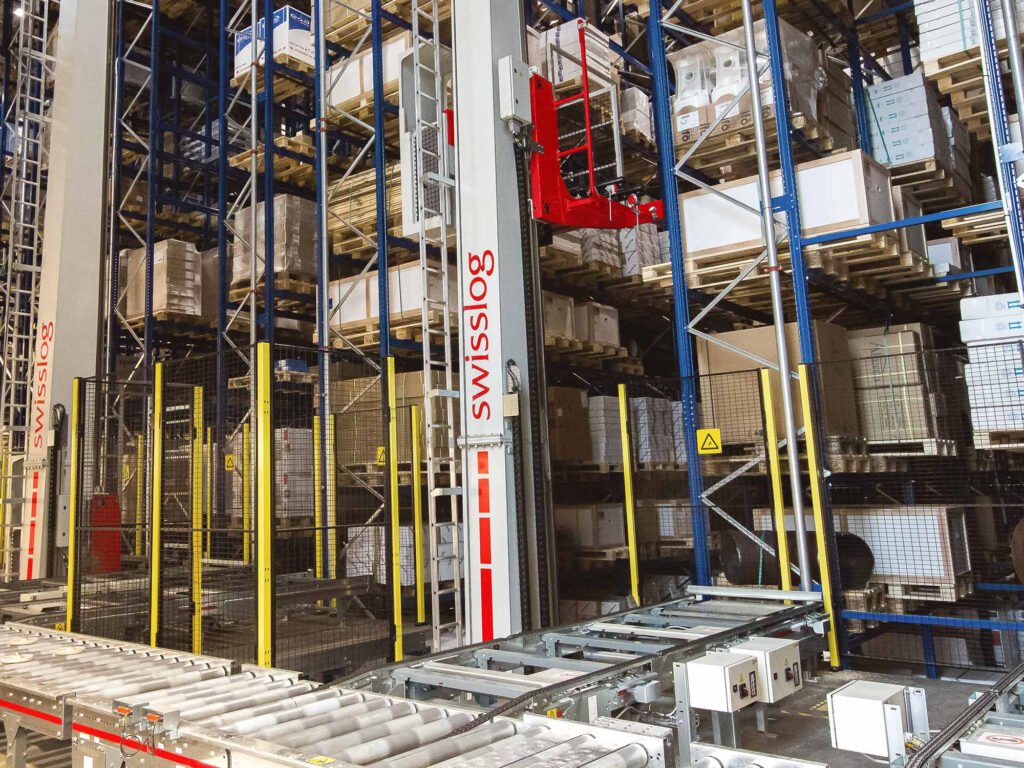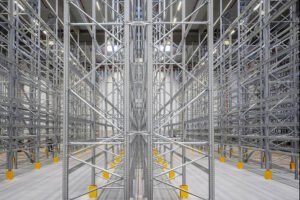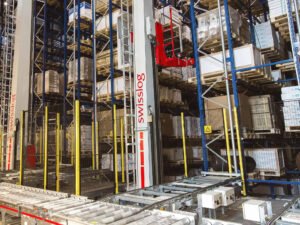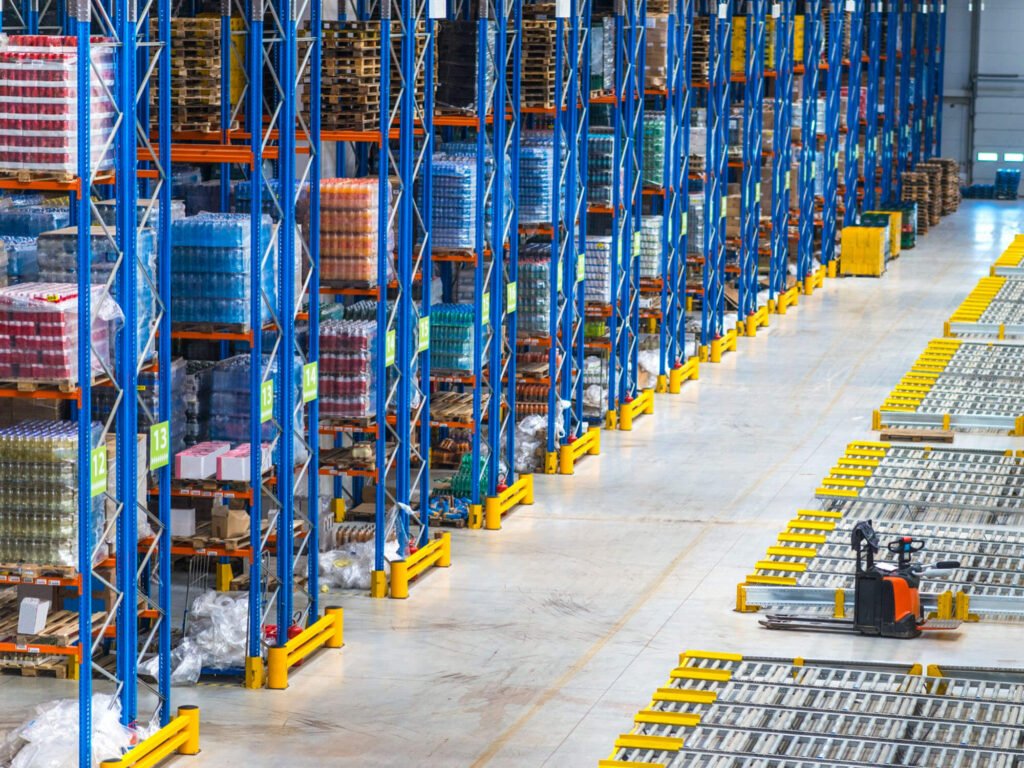Do you want to make your warehouse faster and more organized? Ooh yes! But choosing the right Automated Storage and Retrieval System (ASRS) can be tricky. Don’t worry! Some systems look good but may not fit your warehouse needs.
In this article, you will learn about the 8 main types of ASRS storage systems and how they work. Also, you will learn which system suits your business best. Hence, you can improve efficiency, save space, and reduce labor effortlessly.

Figure 1: Automated Storage and Retrieval Systems (ASRS)
1) Unit-Load ASRS
First of all, the unit Load ASRS is a machine system that lifts and stores heavy goods. It is used for large boxes or pallets. Moreover, it works automatically. It means that no human effort is required. Also, cranes or shuttle vehicles move back and forth along the tracks. Then store the goods upstairs and downstairs.

Figure 2: Unit-Load ASRS
- Key Components:
Next, this system consists of some components like
- First of all, storage racks are used to store goods.
- Next, cranes that lift your goods,
- Then conveyors that move your goods
- Also, the software that controls everything in your unit-load ASRA system.
So all of these parts work together quickly and carefully.
- Ideal Use Cases:
So you use this system where you need to store heavy objects. For example, you use it in factories, warehouses, and cold storage. Also, you can use it in food companies or car manufacturing factories. So it saves your time and makes your work easier.
| Benefits | Limitations |
| Fast pallet handling | High setup cost |
| Saves warehouse space | Needs strong structure |
| Reduces labor work | Limited to small loads |
| Improves safety control | Complex to maintain |
2) Mini-Load ASRS
Next, the mini-load Automated Storage and Retrieval System (ASRS) is used for light and small items. It handles boxes, totes, and small parts with ease. Moreover, it works automatically. So you don’t have to lift or place items. Hence, you’ll use this system in warehouses where small but valuable items are stored.

Figure 3: Mini-Load ASRS
- Key Components:
Next, it has torage racks, light cranes, conveyors, bins, and control software. Then the cranes move in narrow aisles. Then carefully lift or place items. Meanwhile, the software controls each movement to maintain speed.
- Ideal Use Cases:
So you use this system for electronics, appliances, pharmaceuticals, or small retail goods. Also, it is ideal when you need more storage in less space, less labor, and faster work. Therefore, you also use it in healthcare, e-commerce, and parts distribution centers.
| Benefits | Limitations |
| Fast item picking | Limited load weight |
| Saves warehouse space | High setup cost |
| Improves accuracy | Needs regular care |
| Reduces human effort | Not for heavy goods |
3) Carousel-Based ASRS
Then, a carousel-based automated storage and retrieval system (ASRS) stores goods using rotating shelves. Also, it brings the goods to you, rather than you having to go there yourself. So this makes the job faster, easier, and more organized. Therefore, there are two main types:

Figure 4: Carousel-Based ASRS
a) Horizontal Carousels: First of all, the shelves in the horizontal carousel rotate in a circular path. Moreover, it rotates automatically to bring your desired shelf in front of you. So this system is ideal for storing small or medium-sized items. For example, tools, parts, or boxes.
| Benefits | Limitations |
| Fast order picking | High setup cost |
| Reduces labor work | Takes more floor space |
| Easy item access | Not for heavy goods |
| Improves accuracy | Depends on electricity |
b) Vertical Carousels: Next, a vertical carousel moves up and down, rather than rotating. Also, it works like a seesaw that brings the right tray to you. Moreover, compared to a horizontal one, it makes better use of height and saves space for you.
| Benefits | Limitations |
| Saves floor space | High installation cost |
| Reduces worker strain | Height limitations |
| Increases accuracy | Harder maintenance |
| Improves safety | Slower operation speed |
4) Vertical Lift Modules (VLMs)
After that, the Vertical Lift Module (VLM) is a high, closed storage system. It brings items directly to you by moving trays up and down. Also, it uses a computer-controlled lift to ensure that each tray reaches you at the correct height. So this makes the retrieval process fast and error-free.

Figure 5: Vertical Lift Modules (VLMs)
- Working Principle and Design:
Then VLMs have a central lift system with two column trays. So when you select an item. Then the lift pulls out the correct tray and delivers it to the access window. Moreover, sensors and software precisely control every movement. Hence, this system saves floor space. Also makes the best use of vertical space.
- Integration with Warehouse Management Systems (WMS):
So vertical lift storage easily integrates with your warehouse software. Also, you can track inventory in real time. Then manage orders and optimize picking sequences. This makes your warehouse smarter and more organized.
| Benefits | Limitations |
| Fast item picking | High initial cost |
| Saves floor space | Requires maintenance |
| Reduces picking errors | Limited tray size |
| Integrates with WMS | Needs electricity to operate |
5) Robotic Shuttle Systems
Also, the robotic storage system moves your goods in a warehouse. Moreover, they move bins or pallets from one location to another without human assistance. Also, they can move in both horizontal and vertical directions. Then you can store or retrieve items quickly and safely.

Figure 6: Robotic Shuttle Systems
- Key Components:
- Shuttles: First of all, small robots that pick up bins or pallets.
- Rails or tracks: Next, paths that are built for shuttles to move within aisles.
- Racks: Then, multi-level storage where items are kept organized.
- Software and sensors: At last, control the shuttle’s movement and prevent collisions.
- Ideal Use Cases:
- E-commerce fulfillment centers: First of all, you use them for fast picking and shipping of orders.
- Manufacturing warehouses: Next, you use it for raw materials or finished products.
- High-volume storage centers: Then you use it where fast and automated access is essential.
| Benefits | Limitations |
| Fast and accurate picking | High initial investment |
| Easy to scale | Requires technical support |
| Flexible storage | Needs electricity and software |
| Reduces labor | Complex installation |
6) Crane-Based ASRS
Moreover, the crane-based automated storage and retrieval systems (ASRS) use high-stacker cranes to move items in a warehouse. Also, these cranes automatically move pallets into aisles. Moreover, they save your floor space and help keep storage organized.

Figure 7: Crane-Based ASRS
- Key Components: Next, it consists of a high crane frame, a lifting mechanism, a pallet carriage, rails, sensors, and control software. All of these parts work together to move your objects safely.
- Ideal Use Cases: Then you use Crane-based ASRS in high-rack warehouses. So it is best for large pallets, heavy items, and high-volume storage. Also, you use it where vertical space is needed and fast and accurate storage is important.
| Benefits | Limitations |
| High storage density | High setup cost |
| Saves floor space | Needs strong structure |
| Reduces labor work | Maintenance is complex |
| Accurate placement | Not for small items |
7) Cube-Based Storage Systems (AutoStore)
Afterward, the cube-based storage systems, such as AutoStore, stack small bins in a grid to hold items. Also, robots walk over the grid and automatically pick up or place bins. Furthermore, you can use vertical and horizontal space and save your floor space.

Figure 8: Cube-Based Storage Systems (AutoStore)
- Key Components: Next, it consists of bins, a stacking grid, robots, rails, and control software. Moreover, the robots move on the grid, reaching the bins from above. Then the software controls the inventory and movement.
- Ideal Use Cases: Then the cube-based systems are ideal for your e-commerce fulfillment centers and small warehouses. Also, you use it in businesses with fast-moving inventory. So they provide more storage while using less space.
| Benefits | Limitations |
| Maximum space use | High setup cost |
| Fast and precise picking | Needs electricity |
| Flexible and scalable | Maintenance required |
| Low labor needs | Not for large items |
8) Micro-Fulfillment Systems
At last, the microfill Filament Systems are small. You use automated storage systems in urban warehouses or stores. Also, they deliver items quickly to you or to a packing station. Furthermore, these systems are designed for last-mile logistics. So deliveries are fast and efficient.

Figure 9: Micro-Fulfillment Systems
- Key Components: Next, it has small racks, conveyors, robots or shuttles, and control software. So your items are placed in bins and automatically retrieved when needed.
- Ideal Use Cases: Then you use microfill filament for grocery stores, pharmacies, or e-commerce hubs in cities. Also, it comes in handy where space is limited but orders need to be fulfilled quickly.
| Benefits | Limitations |
| Fast item retrieval | High initial cost |
| Saves floor space | Needs electricity |
| Reduces labor | Maintenance required |
| Accurate orders | Not for large items |
9) Comparison Table: ASRS Types at a Glance
As you learn about the 8 types of Automated Storage and Retrieval Systems (ASRS). Now you will learn the comparison of these types in a table.
| ASRS Type | Ideal Load Size | Speed | Scalability | Cost |
| Unit-Load ASRS | Large pallets | Fast | Moderate | High |
| Mini-Load ASRS | Small boxes/totes | Fast | High | Medium-High |
| Horizontal Carousel | Small/medium items | Moderate | Moderate | Medium |
| Vertical Carousel | Small/medium items | Moderate | Moderate | Medium-High |
| Vertical Lift Modules (VLMs) | Small to medium trays | Fast | High | High |
| Robotic Shuttle Systems | Bins/pallets | Very fast | High | High |
| Crane-Based ASRS | Large pallets | Fast | Moderate | Very-High |
| Cube-Based Systems (AutoStore) | Small bins | Fast | Very High | High |
| Micro-Fulfillment Systems | Small bins/items | Very fast | Moderate | Medium-High |
10) How to Choose the Right ASRS for Your Business
As you learn about the different systems. Now you will learn about the factors to make the best decision to choose the right ASRS, depending on your needs.

Figure 10: How to Choose the Right ASRS
i) Load Type and Size: First of all, you think about the type of items you have. For example, for larger pallets, a unit-load or crane-based ASRS is best. Then, for smaller boxes or bins, mini-load, carousel, or cube-based systems are best.
ii) Space Availability: Next, you also measure warehouse space. So vertical systems such as VLMs or vertical carousels save floor space. Also, cube-based systems make the best use of both vertical and horizontal space.
iii) Throughput and Speed Requirements: Then, you decide quickly which items need to be removed or stored. Also, robotic shuttles and microfill filament systems are ideal for your high-speed operations.
iv) Scalability: After that, you think about future growth. For that, robotic shuttles and cube-based storage can be easily expanded.
v) Budget and Costs: Afterward, you also need to consider installation, maintenance, and operational costs. Also, high-quality systems such as crane-based ASRS are expensive, but provide more storage and accuracy.
vi) Integration with Warehouse Management Software (WMS): At last, make sure your ASRS can connect with your WMS. So this makes inventory tracking, order management, and automation more efficient.
Conclusion
In short, automated storage and retrieval systems (ASRS) can speed up your warehouse. Also, you save floor space and reduce labor. Moreover, each type, from unit-load to micro-fill filament, offers you unique benefits. So, you can choose according to your equipment, speed, and budget.
Furthermore, at Lracking, we provide the best ASRS solution for your warehouse. Ultimately, improve your storage and efficiency. Contact us to get started today.




